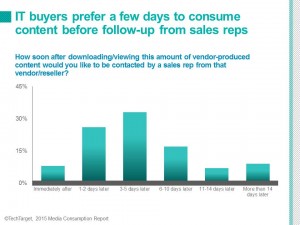- February 24, 2015
- Content, Demand Generation, Sales and Marketing Alignment
How to Kill a Sales Opportunity in 3 Simple Steps
 In a market where both upstarts and 800 lb gorillas are competing for business, it is critical to make the most of every opportunity. But creating and capitalizing on technology marketing and sales opportunities in today’s economy is no easy task. It takes a lot of hard work, collaboration, and sometimes, long periods of time to achieve success.
In a market where both upstarts and 800 lb gorillas are competing for business, it is critical to make the most of every opportunity. But creating and capitalizing on technology marketing and sales opportunities in today’s economy is no easy task. It takes a lot of hard work, collaboration, and sometimes, long periods of time to achieve success.
Unfortunately for you and your sales teams, it takes far less time to kill an opportunity than it does to create it.
In order to prevent this from happening to you, you must recognize the things that will nail the coffin on your opportunities and avoid them like the plague.
3 things that will kill all marketing and sales opportunities
There are lots of things that can negatively impact deals, some of which are out of your hands. But most deals are killed from the inside and here is why:
1. Carts are not meant to come before horses
Ever heard the expression “time is the death of all deals”? There certainly is some truth to this, but a much more powerful expression to consider is this: “Impatience causes wise people to do foolish things.” It is not time that kills deals, it is impatience. In your rush to follow-up immediately on that lead that came in, you forgot to apply common sense.

To illustrate this point, let’s take a look the most common form of lead generation for technology marketing and sales teams: white papers. According to TechTarget’s latest Media Consumption study, the vast majority of technology buyers think that vendor sales reps should wait at least 3-5 days before following up with them after they have downloaded your white paper. Only 8% want to be followed up on immediately. Remember, the average buy cycle is 3-6 months long – not 1 day.
Those who immediately dial for dollars after someone downloads one of your assets, take a step back and think about two things:
- It’s not about your instant gratification – IT guys are very busy planning and researching projects that they need answers for. Your white paper is merely one piece of that research. Waiting just a couple more days may allow that buyer to consume your information and place it into context with their current project which will put your outreach on their terms and make it much more timely.
- Let them get past Chapter 1 – As much as it may hurt to hear, most technology buyers will not always read through your entire white paper. That being said, unless they are speed reading savants, there is no chance they will read it if you follow up immediately.
2. You don’t bring a knife to a gun fight
 Being an under-informed sales rep is the equivalent of bringing a knife to a gun fight. In other words, the less you know about your prospects, the more un-prepared you are to win the battle (i.e. their business). But fear not knife-wielding sales reps, there is a remedy for what ails you: intelligence.
Being an under-informed sales rep is the equivalent of bringing a knife to a gun fight. In other words, the less you know about your prospects, the more un-prepared you are to win the battle (i.e. their business). But fear not knife-wielding sales reps, there is a remedy for what ails you: intelligence.
In order to be properly armed to have meaningful, productive conversations, sales reps need to know more about a prospect’s needs. Technology buyers don’t want to pick up the phone and hear a hard sales pitch. They want advice, they want a rep to be consultative and work with them to find a solution to their problems. In other words, they want reps to be more buyer-centric rather than seller-centric.
Without the proper intelligence, this would be impossible. It is up to marketing to get the right info at the right time to fuel sales opportunities. it is is up to sales to use it.
3. No shirt, no shoes, no content…
 You guessed it: no service.
You guessed it: no service.
Content is a technology buyer’s lifeline to the projects they are managing. The proliferation of content available allows buyers to self-educate themselves about your brand and your solutions. Without content, your marketing and sales opportunities are truly dead in the water. In fact, you never even get the chance to make mistake #1 and mistake #2 if you make mistake #3.
The typical buyer downloads at least 4 pieces of content before shortlisting a vendor (TechTarget media Consumption). Considering average buying teams consist of 2-5 members, you need between 8 and 32 pieces of content to effectively cover the collective needs of the accounts you are targeting. Marketers are putting their sales teams at an extreme disadvantage if they are not creating the content needed to shepherd buyers through the sales cycle.
Set up your sales teams for success, not failure: If you don’t have the right mix of content to offer to buyers, I would suggest working with a third party or your media partners to help fill any gaps you have in your content portfolio.
I am interested to hear your advice about your successes and failures when it comes to opportunity generation and management. Please feel free to leave a comment or connect with me on Twitter or LinkedIn.
Deal, No Deal image via Shutterstock.
B2B marketing, b2b technology buyers, conetnt marketing, content development, media consumption research, opportunity generation, opportunity management, sales and marketing alignment, sales opportunities



